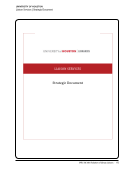88 · Survey Results: Survey Questions and Responses
We are planning on utilizing both quantitative feedback such as number of sessions taught, as well as liaison’s own
impressions of how goals are going and informal feedback from departments (do they know who their liaison is, etc.)
41. What methods of communication have been established to ensure that information gathered by
liaisons is considered in the library’s decision-making processes? N=53
Administrators attend monthly liaison meetings.
Analysis and feedback from data collection, debriefings with liaisons
Both personal communication with department leadership and with Associate Dean
Department meetings with UL/AUL and liaisons, feedback through various channels
Department meetings, retreats, library newsletters
Detailed statistics, strategic planning conversations, sharing information with appropriate Associate Director
Email, meetings
Email
Faculty meetings, annual reviews through supervisors
Feedback from departments on collection needs is reported via a content advisory group made up of subject librarians.
Monthly liaison meetings are one way that liaisons communicate with associate deans who may attend. Liaison
coordinator meets with Associate Dean of Collection Development and Access and the Associate Dean for Research &
Learning Services and to the Dean of Libraries.
Feedback from students and faculty, repeat visits/requests
Frequent meetings of liaisons and subject teams and with supervisors, department heads, and associate directors
to discuss faculty and student needs and service strategies. Annual Activity Reports are reviewed and discussed in
the appraisal process, so that emerging challenges, solutions, trends, and accomplishments can be shared among
administrators and taken into consideration during decision making. A structured Library Representatives group brings
together faculty and graduate students from all academic departments with the vice provost &director of libraries, other
administrators, and the liaisons, to share information and discuss library resources, services, and strategies.
Information is located on an intranet and may be accessed by any library staff or faculty member.
Information is solicited from liaisons by the department heads, who communicate it to their associate dean in regular
(biweekly) meetings. Liaisons may also contribute to targeting information-gathering efforts related to the library
budget or strategic directions.
Information literacy assessments, strategic planning metrics
Liaisons are members of most library committees. Liaisons communicate issues directly to their department chairs and
AUL for Public Services as well as the AUL over collection development. Liaisons meet formally as a group in the Library
Liaison Group and the group’s chair meets monthly with the AUL for Public Services.
Liaisons bring info to “reference” department meeting and it is funneled by department head to HSCL director. Liaisons
bring info to HSCL senior management meeting, which the director attends. Liaisons email director directly (copying
reference head).
We are planning on utilizing both quantitative feedback such as number of sessions taught, as well as liaison’s own
impressions of how goals are going and informal feedback from departments (do they know who their liaison is, etc.)
41. What methods of communication have been established to ensure that information gathered by
liaisons is considered in the library’s decision-making processes? N=53
Administrators attend monthly liaison meetings.
Analysis and feedback from data collection, debriefings with liaisons
Both personal communication with department leadership and with Associate Dean
Department meetings with UL/AUL and liaisons, feedback through various channels
Department meetings, retreats, library newsletters
Detailed statistics, strategic planning conversations, sharing information with appropriate Associate Director
Email, meetings
Faculty meetings, annual reviews through supervisors
Feedback from departments on collection needs is reported via a content advisory group made up of subject librarians.
Monthly liaison meetings are one way that liaisons communicate with associate deans who may attend. Liaison
coordinator meets with Associate Dean of Collection Development and Access and the Associate Dean for Research &
Learning Services and to the Dean of Libraries.
Feedback from students and faculty, repeat visits/requests
Frequent meetings of liaisons and subject teams and with supervisors, department heads, and associate directors
to discuss faculty and student needs and service strategies. Annual Activity Reports are reviewed and discussed in
the appraisal process, so that emerging challenges, solutions, trends, and accomplishments can be shared among
administrators and taken into consideration during decision making. A structured Library Representatives group brings
together faculty and graduate students from all academic departments with the vice provost &director of libraries, other
administrators, and the liaisons, to share information and discuss library resources, services, and strategies.
Information is located on an intranet and may be accessed by any library staff or faculty member.
Information is solicited from liaisons by the department heads, who communicate it to their associate dean in regular
(biweekly) meetings. Liaisons may also contribute to targeting information-gathering efforts related to the library
budget or strategic directions.
Information literacy assessments, strategic planning metrics
Liaisons are members of most library committees. Liaisons communicate issues directly to their department chairs and
AUL for Public Services as well as the AUL over collection development. Liaisons meet formally as a group in the Library
Liaison Group and the group’s chair meets monthly with the AUL for Public Services.
Liaisons bring info to “reference” department meeting and it is funneled by department head to HSCL director. Liaisons
bring info to HSCL senior management meeting, which the director attends. Liaisons email director directly (copying
reference head).












































































































































































































